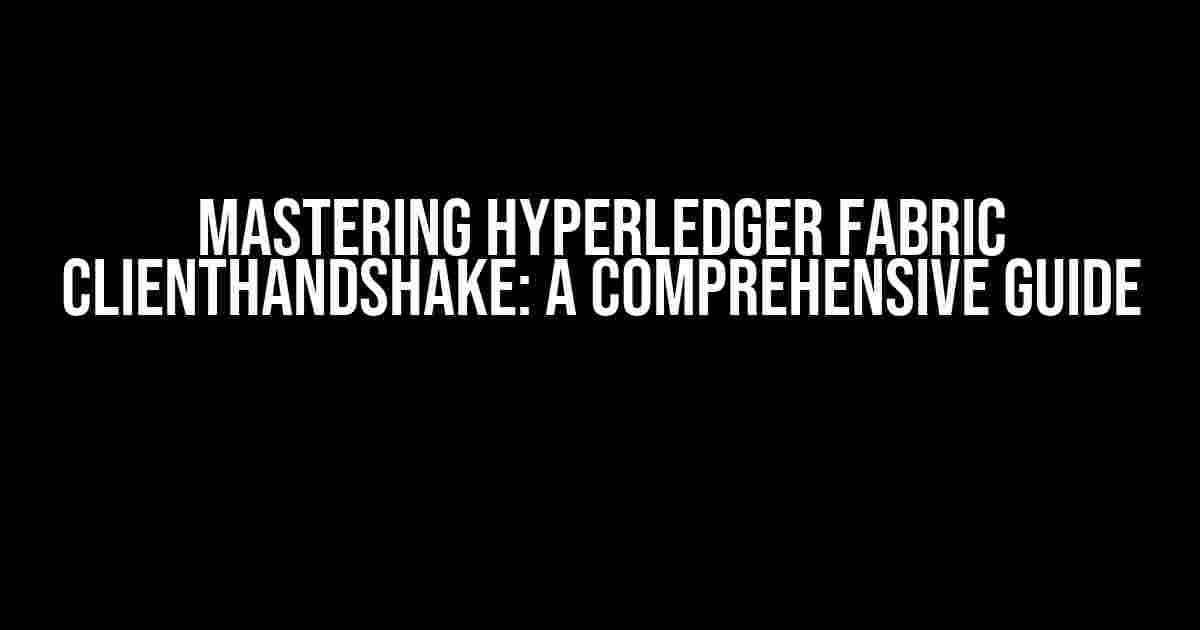Are you tired of grappling with the complexities of Hyperledger Fabric’s ClientHandshake? Do you want to master the art of secure communication between clients and peers in your blockchain network? Look no further! In this exhaustive guide, we’ll delve into the world of ClientHandshake, demystifying its concepts, and providing step-by-step instructions to get you up and running in no time.
What is Hyperledger Fabric ClientHandshake?
In Hyperledger Fabric, ClientHandshake is a crucial component that enables secure communication between clients and peers. It’s a handshake protocol that establishes a trusted connection, ensuring the integrity and confidentiality of data exchanged between the two parties. Think of it as a digital equivalent of a firm handshake, where both parties agree on the terms of engagement before proceeding.
Why is ClientHandshake Essential?
Without ClientHandshake, your blockchain network would be vulnerable to attacks, making it an attractive target for malicious actors. Here are some compelling reasons why ClientHandshake is essential:
- Authentication**: ClientHandshake ensures that clients and peers authenticate each other, preventing impersonation attacks.
- Encryption**: The handshake protocol enables the exchange of encryption keys, securing data in transit.
- Authorization**: ClientHandshake verifies the permissions and access control lists, ensuring that only authorized parties can access and modify data.
How Does Hyperledger Fabric ClientHandshake Work?
Now that we’ve established the importance of ClientHandshake, let’s dive into its inner workings. The process can be broken down into three distinct phases:
- Connection Establishment**: The client initiates the connection by sending a `Hello` message to the peer.
- Key Exchange**: The peer responds with its public key, and the client generates a shared secret key using the peer’s public key and its own private key.
- Authentication and Authorization**: The client sends an `Auth` message, including its credentials and the shared secret key. The peer verifies the credentials and responds with an `AuthResponse` message, containing the authorization information.
ClientHandshake Protocol Messages
Here’s a breakdown of the ClientHandshake protocol messages:
| Message Type | Description |
|---|---|
| HELLO | Client initiates the connection with the peer. |
| KEY_EXCHANGE | Peer responds with its public key. |
| AUTH | Client sends its credentials and shared secret key. |
| AUTH_RESPONSE | Peer responds with authorization information. |
Implementing ClientHandshake in Your Hyperledger Fabric Application
Now that we’ve covered the theoretical aspects, let’s get our hands dirty and implement ClientHandshake in a Hyperledger Fabric application!
Prerequisites
Before we begin, ensure you have:
- Hyperledger Fabric v2.2 or later installed on your system.
- A basic understanding of Go programming language (we’ll use it for our example).
- A Hyperledger Fabric network set up with at least one peer and one client.
Step 1: Create a Go Client Application
Create a new Go file, e.g., `main.go`, and add the following code:
package main
import (
"fmt"
"github.com/hyperledger/fabric-sdk-go/pkg/client/resmgmt"
"github.com/hyperledger/fabric-sdk-go/pkg/common/providers/fab"
)
func main() {
// Create a new Fabric client
client, err := resmgmt.New(resmgmt.WithClientConfig("path/to/config.yaml"))
if err != nil {
fmt.Println(err)
return
}
// Set the target peer URL
url := "grpcs://localhost:7051"
// Create a new connection
conn, err := client.Connection(url)
if err != nil {
fmt.Println(err)
return
}
}
Step 2: Establish a ClientHandshake Connection
Add the following code to establish a ClientHandshake connection:
// Perform a ClientHandshake
handshake, err := conn.Handshake()
if err != nil {
fmt.Println(err)
return
}
// Verify the handshake response
if handshake.GetStatus() != fab.Status_SUCCESS {
fmt.Println("Handshake failed:", handshake.GetStatus())
return
}
fmt.Println("ClientHandshake established successfully!")
Step 3: Send a Transaction Proposal
Now that we have a secure connection, let’s send a transaction proposal:
// Create a new transaction proposal
NewProposal := &fab.SignedProposal{
Proposal: &fab.Proposal{
Header: &fab.CommonHeader{
ChannelHeader: fab.ChannelHeader{
ChannelId: "mychannel",
},
},
Payload: []byte("This is a sample transaction"),
},
}
// Send the transaction proposal
proposalResp, err := conn.Propose(NewProposal)
if err != nil {
fmt.Println(err)
return
}
fmt.Println("Transaction proposal sent successfully!")
Conclusion
Voilà! You’ve successfully implemented ClientHandshake in your Hyperledger Fabric application. By following these steps, you’ve ensured secure communication between your client and peer, safeguarding your blockchain network from potential threats.
Remember, ClientHandshake is an essential component of Hyperledger Fabric’s security architecture. By mastering it, you’ll be well-equipped to build robust, secure, and scalable blockchain applications.
What’s Next?
Now that you’ve conquered ClientHandshake, it’s time to explore other exciting aspects of Hyperledger Fabric, such as:
- Chaincode development and deployment
- Smart contract architecture and design patterns
- Blockchain network management and scaling
Stay curious, keep learning, and happy coding!
Keywords: Hyperledger Fabric, ClientHandshake, blockchain, security, authentication, authorization, encryption, Go, programming, tutorial, guide.
Frequently Asked Questions
Get answers to your burning questions about Hyperledger Fabric Client Handshake!
What is Hyperledger Fabric Client Handshake and why is it important?
Hyperledger Fabric Client Handshake is a critical component of the Fabric network that enables secure communication between clients and peers. It facilitates the establishment of a trusted connection, allowing clients to send proposals and receive responses from the network. Think of it as a digital “hello” and “who are you?” simultaneous exchange that sets the stage for a secure and trusted conversation.
How does the Client Handshake process work in Hyperledger Fabric?
The Client Handshake process involves a series of exchanges between the client and the Fabric peer. It starts with the client sending a handshake proposal to the peer, which includes the client’s identity and credentials. The peer responds with a handshake response, containing its own identity and a session key. The client then verifies the peer’s identity and sends an encrypted message, which the peer decrypts using the session key. This back-and-forth authentication and key exchange establish a secure connection between the client and peer.
What is the difference between a session key and a TLS key in Hyperledger Fabric?
In Hyperledger Fabric, a session key is a symmetric key generated during the Client Handshake process, used for encrypting and decrypting messages between the client and peer. On the other hand, a TLS (Transport Layer Security) key is an asymmetric key used for establishing a secure connection between the client and peer, ensuring data integrity and confidentiality. Think of the session key as a “coffee shop password” for your conversation, while the TLS key is the “front door key” that lets you enter the coffee shop securely.
Can I customize the Client Handshake process in Hyperledger Fabric?
Yes, you can! Hyperledger Fabric provides a pluggable architecture, allowing you to customize the Client Handshake process by implementing your own custom handshake protocol or modifying the existing one. This flexibility enables you to meet specific security requirements or integrate with existing authentication systems. Just keep in mind that any customizations should adhere to Fabric’s security guidelines and best practices.
How does the Client Handshake impact the performance of my Hyperledger Fabric network?
The Client Handshake process can introduce additional latency and overhead, especially during the initial connection establishment. However, Fabric’s design minimizes the performance impact by caching session keys and reusing them for subsequent interactions. Additionally, you can optimize performance by tuning the handshake protocol, using more efficient cryptographic algorithms, and fine-tuning your network configuration. Just remember to balance performance with security considerations to ensure a trusted and efficient Fabric network.



